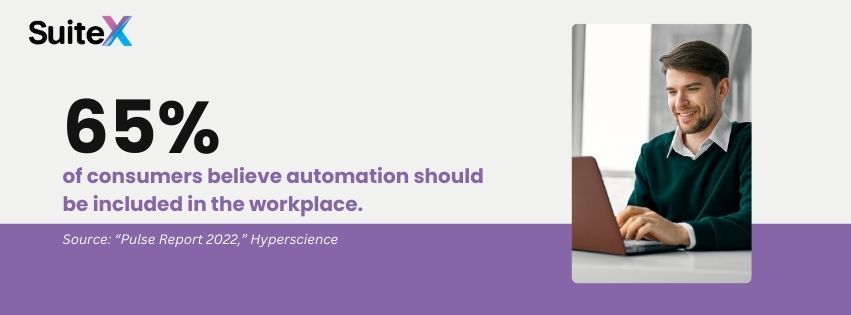The Hidden Costs of Manual Data Entry (And How the SuiteX iPaaS Eliminates Them)
Nothing can hold a company back like manual data entry. Here's how to eliminate it.
Manual data entry may seem like a simple solution when platforms don’t communicate. However, it’s not. It can make matters so much worse. Manual input can slow operations significantly and introduce costly errors your business can’t afford.
We know how much sluggish processes and grave mistakes can damage your company. The SuiteX Integration Platform as a Service (iPaaS) helps eliminate these issues using automated workflows and bidirectional data sync. It ensures data flows freely and automatically between all your systems and logs errors as they happen.
Read our guide below on the negative impact manual entry can have on your entire organization. Then, schedule a SuiteX demo with our team. The platform offers seamless data transfer that ensures your company runs smoothly—without fear of expensive errors.
Key Takeaways
- Manual data entry costs businesses significantly more than labor hours. It creates cascading financial impacts, including error correction costs, operational inefficiencies, and opportunity costs.
- According to research, manual data entry has approximately a 1% error rate. Employees spend about 10% of their work time on manual entry tasks and lose an average of 60 hours monthly to functions that could be automated.
- Consumer sentiment supports automation, with 65% of consumers believing it should be incorporated into the workplace. This indicates that it's not just an internal efficiency measure but a customer expectation.
- SuiteX iPaaS transforms business operations by creating a unified digital ecosystem with automated data synchronization, pre-mapped integrations to significant platforms, and bidirectional syncing capabilities.
- iPaaS solutions eliminate the immediate costs of manual data entry (labor, errors, reconciliation time) and provide strategic advantages by redirecting human resources toward innovation and enabling real-time decision-making.

The Price Tag of Manual Data Entry
At first glance, manual data entry might seem like a slow, operational inconvenience. Yet, manual input can cause serious problems that hamper your company's chances of competing. Transferring information from one system to another creates a cascade of hidden costs throughout your organization.
These expenses silently erode profit margins while creating friction in nearly every business process. Manual data practices drain resources in ways that rarely appear on traditional balance sheets, including salary hours dedicated to repetitive keystrokes and the compounding effect of minor errors that grow into significant discrepancies.
It’s even more concerning how these inefficiencies compound over time. They create operational bottlenecks and strategic disadvantages, while competitors with streamlined data flows can respond more quickly to market opportunities, access real-time insights, and dedicate human capital to innovation rather than maintenance.
The actual cost of manual data entry isn't measured just in dollars spent but in missed opportunities and unrealized growth potential. This shift toward automation isn't merely a business preference—it reflects broader societal recognition of its value. In fact, 65% of consumers believe automation should be included in the workplace, according to Hyperscience’s “Pulse Report 2022.”
This consumer sentiment indicates that automation isn't merely an internal efficiency play but an expectation that influences how customers perceive your business operations and reliability.
Direct Financial Costs of Manual Entry
A 2024 ProcessMaker report says the average office worker spends 10% of their work time in manual entry. These tedious, easily automated tasks carry high costs for companies, including:
Labor Expenses: Unnecessary staff hours can cost a company thousands monthly—and could be directed toward growth initiatives instead.
Other manual entry issues include:
- Overtime Costs: Data synchronization often requires overtime pay during high-volume periods like holiday seasons.
- Training Investment: New employees need extensive training on multiple systems and entry protocols, increasing onboarding costs.
Operational Inefficiencies
- Processing Delays: Manual entry creates bottlenecks that slow down order processing, inventory updates, and financial reporting. A study commissioned by Automation Anywhere reports that employees lose an average of 60 hours monthly to easily automated tasks.
- Resource Diversion: IT and operations teams spend valuable time troubleshooting data discrepancies rather than focusing on strategic improvements.
- Delayed Decision-Making: Without real-time data synchronization, leadership makes decisions based on outdated information.

Real-World Impact
Consider this scenario: A medium-sized retailer sells through their own website, Amazon, and several major retail partners manually transfer orders, inventory, and customer data between systems. Each month, they experience:
- 2-3 inventory discrepancies leading to overselling or stockouts
- 5-7 hours of reconciliation work per week
- 1-2 delayed financial reports
- Multiple instances of customer service issues stemming from data errors
Over a year, these seemingly minor issues compound into significant financial and reputational damage.
How iPaaS Eliminates Hidden Costs
Integration Platform as a Service (iPaaS) solutions like SuiteX fundamentally transform how your business systems communicate, eliminating hidden costs through automated workflows and bridging gaps between previously siloed applications.
SuiteX iPaaS creates a unified digital ecosystem, establishing persistent connections that synchronize data across your technology landscape without human intervention. This consolidation eliminates labor costs, processing delays, and error-prone manual procedures while improving the organization’s data consistency, accuracy, and availability.
Automated Data Synchronization
SuiteX iPaaS creates seamless connections between NetSuite and your tech stack, ensuring data flows automatically between systems. This automation:
- Eliminates human error in data transfer
- Ensures real-time data consistency across platforms
- Frees staff to focus on value-adding activities
- Scales effortlessly with transaction volume
Pre-Mapped Integrations
SuiteX stands out by offering pre-mapped integrations with major platforms, including:
- E-commerce channels like Shopify, Amazon, and eBay
- Retail partners including Target, Walmart, Wayfair, Bed Bath & Beyond, Macy's, and Kohl's
- Business tools such as Power BI and Salesforce
These prepared connections dramatically reduce implementation time and ensure robust, tested data flows from day one.

Bidirectional Synchronization
Changes made in any connected software automatically update across your entire ecosystem. This two-way sync:
- Maintains a single source of truth
- Reduces reconciliation efforts
- Enables real-time decision-making
- Prevents data conflicts
User-Friendly Error Management
Even in automated systems, exceptions occur. SuiteX's error-logging capabilities:
- Immediately identify synchronization issues
- Provide detailed diagnostic information
- Enable quick resolution without technical expertise
- Prevent cascading data problems
Grow More Efficient and More Accurate
Manual data entry isn't just inefficient—it's a significant hidden cost that impacts your bottom line, team morale, and competitive positioning. The SuiteX iPaaS automates workflows and introduces automatic bidirectional data sync into your processes so your operations run faster and smoother and your records remain accurate.
The question isn't whether you can afford integration technology—it's whether you can continue absorbing the hidden costs of manual data entry.
Schedule your free SuiteX demo with our team today and discover how far your business can go when it’s not hampered by manual input.
Frequently Asked Questions
1. How long does a typical SuiteX iPaaS implementation take from start to finish?
SuiteX iPaaS integrations are simple and can be completed within a few weeks without disrupting your company’s daily operations.
2. What happens if my business needs change and I need to add new integration points after implementation?
SuiteX iPaaS is designed for flexibility and scalability. Adding new integration points to your existing setup is straightforward and doesn't require rebuilding your entire integration framework. Our system uses a modular architecture, allowing easy expansion as your business grows or your technology ecosystem evolves.
3. How does SuiteX iPaaS handle sensitive customer data and maintain security across multiple platforms?
SuiteX iPaaS employs enterprise-grade security measures, including data encryption in transit and at rest, role-based access controls, and regular security audits. All data transfers between systems occur through secure API connections with proper authentication mechanisms, ensuring your customer information remains protected while moving seamlessly between platforms.
4. How much can SuiteX actually save on our NetSuite licensing costs?
Most organizations implementing SuiteX experience NetSuite licensing cost reductions of up to 50%. The software achieves this by providing modern, user-friendly interfaces that extend system access to your entire team without requiring full licenses for every user. Meanwhile, it maintains perfect data integrity within your NetSuite environment.
Disclosure: This article was developed with the assistance of Claude, an AI created by Anthropic. Our editorial team used Claude as a collaborative writing tool, carefully reviewing, editing, and fact-checking all AI-generated content. The final text has been thoroughly vetted to ensure accuracy, clarity, and alignment with SuiteDynamics' editorial standards. We take full responsibility for the content presented in this article, maintaining our commitment to providing reliable and informative insights to our readers.










